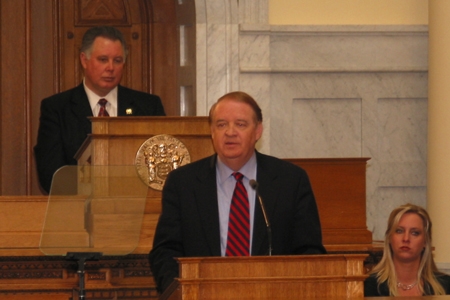
New Jersey’s Initiative Will Generate Over $2 Billion in Economic Benefits
TRENTON – New Jersey stands to reap nearly $2.2 billion in economic benefits from its stem cell research investments, according to a new Rutgers University study unveiled today by Senate President Richard J. Codey. The study, which was prepared by Professor Joseph J. Seneca of the Edward J. Bloustein School of Planning and Public Policy, also estimates that the state can expect to benefit from roughly 30,000 new job-years and $115 million in additional state revenue from New Jersey’s stem cell research initiative.
“Our chief concern has always been to save lives, reduce suffering, and improve the overall human condition,” said Codey. “To be able to do this, while investing in our economy, creating jobs and boosting revenue, is enormously inspiring. This study shows that the impact of our stem cell investments is dramatic in terms of revolutionizing health care treatment and protecting the lifeblood of our economy – our pharmaceutical and biotechnology industries.”
The study was conducted at the Senate President’s request, as a follow-up to a 2005 study that Codey had commissioned based on the state’s previously proposed investment of $380 million in stem cell research initiatives. Since that time, the total investment approved by the state has expanded to $720 million – $270 million for capital construction costs for a world-class Stem Cell Institute and several other stem cell and biomedical research facilities; and a $450 million bond referendum on this November’s ballot that would provide long-term funding for stem cell research grants.
While the analysis of these benefits is complex and dependent on many variables, the study examined the components that would most likely be attributed directly to the state’s proposed initiative: economic impact of expenditures, the retention and expansion of the state’s biotechnology industry and royalty payments that might accrue to the state as a result of the creation of a successful stem cell therapy. The benefits are expected to occur over the 2009 to 2025 period.
“New Jersey’s biotechnology and pharmaceutical industries are vitally important economic engines for the state. The stem cell initiative will help ensure that these sectors continue to thrive in New Jersey and contribute significantly to the economy of the state,” said Professor Seneca. “By this strategic investment in stem cell research, New Jersey continues its scientific legacy as a source of profound improvements in how we live and how well we live, with accompanying large increases in income, employment, and state resources.”
In the 2005 report, Seneca estimated that New Jersey stood to benefit from an estimated $1.4 billion in new economic activity, approximately 20,000 new jobs and $71.9 million in new state revenue. Since that time, New Jersey’s investment has grown significantly, bringing with it the potential for enormous economic benefits.
Highlights of the new study include:
Economic and Fiscal Impacts of Public Expenditures
Combined Impacts — It is estimated that the total of $720 million in public expenditures on facilities, equipment, and research will generate in New Jersey:
– $546.7 million in additional Gross Domestic Product (GDP)
– 7,766 direct and indirect job-years (one job-year is equal to one job
lasting one year)
– $475.3 million in income
– $19.7 million in state taxes
– $21.8 million in local taxes
Retention and Expansion of the Biotechnology and Pharmaceutical Industries
It is estimated that the initiative would result in $1.6 billion in private life sciences research investments and $405 million in associated capital expenditures that would not have occurred in
the absence of the public effort. As with the public expenditures, this $2 billion in private sector investments would have significant economic and fiscal impacts, including:
– $1.6 billion in additional GDP
– 22,062 direct and indirect job-years
– $1.4 billion in income
– $56.5 million in state taxes
– $62.3 million in local taxes
Broader Benefits to New Jersey
A broader aggregation of potential stem cell therapy benefits to New Jersey consisting of reductions in health care costs, savings in work time lost, and decreases in premature deaths will occur regardless of where the actual therapies are developed. It is estimated that the economic benefits to New Jersey of successful stem cell therapies to treat the six conditions examined in the report would total almost $73 billion, including:
– $11.3 billion in reduced medical costs
– $813 million due to reductions in lost workdays
– $60.7 billion in premature deaths avoided.
A full copy of the report is available online at: http://www.policy.rutgers.edu/reports/other/stemcelloct07.pdf . For additional questions on the report, Professor Seneca can be contacted at 732-932-2993, ext. 757, or at seneca@rci.rutgers.edu

